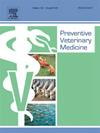A GIS-based framework for routing decisions to reduce livestock disease exposure risk
IF 2.2
2区 农林科学
Q1 VETERINARY SCIENCES
引用次数: 0
Abstract
Safe and effective transportation of livestock during disease outbreaks is crucial for maintaining agricultural productivity and economic stability. This work offers a novel perspective on the transportation of hazardous biological materials within the veterinary field. In response to the complex challenges of managing livestock disease outbreaks, we evaluated different routing measures for safe land transport of diseased animals or infected materials. The potential disease exposure risk to susceptible livestock populations during hypothetical transportation scenarios of infected livestock and specimens was estimated. A GIS-based framework was developed to integrate and manage raster-based Gridded Livestock of the World (GLW) data and vector-based road network data, which was used to implement a time-based risk (TBR) measure to support routing decisions of diseased animals. This approach not only considers time as a traditional routing metric but also incorporates livestock population distribution as a crucial factor in the disease exposure risk assessment. Along with the TBR measure, the shortest, fastest, and least population exposure measures are also evaluated as routing solution benchmarks. Analysis results based on two origin-destination pairs within Oklahoma, USA demonstrate that the TBR measure yields routes with the least impact on animal populations as compared to the shortest, fastest, and least population route, especially over longer distances. Our results underscore the importance of incorporating dynamic exposure risks in routing decisions to effectively minimize potential disease spread to vulnerable populations distributed along the path of transportation. This study also highlights the potential of GIS in enhancing biosecurity and disease control measures by optimizing transportation routes that consider various risk factors.
基于地理信息系统的路线决策框架,以减少牲畜疾病暴露风险
在疾病暴发期间安全有效地运输牲畜对维持农业生产力和经济稳定至关重要。这项工作为兽医领域内危险生物材料的运输提供了一个新的视角。为了应对管理牲畜疾病暴发的复杂挑战,我们评估了用于安全陆路运输患病动物或受感染材料的不同路线措施。在假定的受感染牲畜和标本运输情景中,对易感牲畜群体的潜在疾病暴露风险进行了估计。开发了一个基于gis的框架,用于整合和管理基于栅格的世界牲畜网格(GLW)数据和基于矢量的路网数据,并使用该框架实施基于时间的风险(TBR)措施,以支持患病动物的路由决策。该方法不仅将时间作为传统的路径度量,而且将牲畜种群分布作为疾病暴露风险评估的关键因素。除了TBR度量之外,还将最短、最快和最少人口暴露度量作为路由解决方案基准进行评估。基于美国俄克拉何马州的两个始发-目的地对的分析结果表明,与最短、最快、种群最少的路线相比,TBR测量得出的路线对动物种群的影响最小,特别是在较长距离上。我们的研究结果强调了将动态暴露风险纳入路线决策的重要性,以有效地减少潜在的疾病传播给分布在运输路径沿线的脆弱人群。该研究还强调了地理信息系统通过优化考虑各种风险因素的运输路线,在加强生物安全和疾病控制措施方面的潜力。
本文章由计算机程序翻译,如有差异,请以英文原文为准。
求助全文
约1分钟内获得全文
求助全文
来源期刊

Preventive veterinary medicine
农林科学-兽医学
CiteScore
5.60
自引率
7.70%
发文量
184
审稿时长
3 months
期刊介绍:
Preventive Veterinary Medicine is one of the leading international resources for scientific reports on animal health programs and preventive veterinary medicine. The journal follows the guidelines for standardizing and strengthening the reporting of biomedical research which are available from the CONSORT, MOOSE, PRISMA, REFLECT, STARD, and STROBE statements. The journal focuses on:
Epidemiology of health events relevant to domestic and wild animals;
Economic impacts of epidemic and endemic animal and zoonotic diseases;
Latest methods and approaches in veterinary epidemiology;
Disease and infection control or eradication measures;
The "One Health" concept and the relationships between veterinary medicine, human health, animal-production systems, and the environment;
Development of new techniques in surveillance systems and diagnosis;
Evaluation and control of diseases in animal populations.
 求助内容:
求助内容: 应助结果提醒方式:
应助结果提醒方式:


